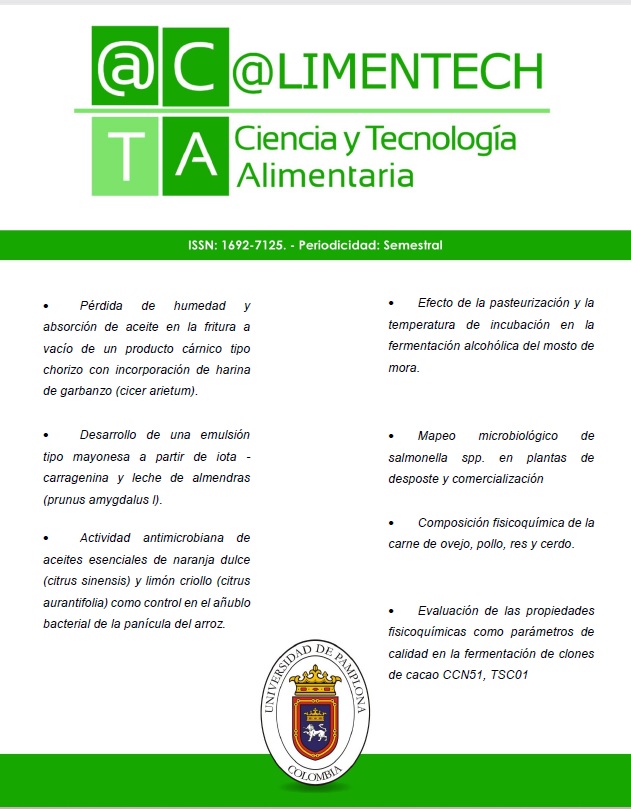Pérdida de humedad y absorción de aceite en la fritura a vacío de un producto cárnico tipo chorizo con incorporación de harina de garbanzo (cicer arietum)
DOI:
https://doi.org/10.24054/limentech.v15i2.2178Palabras clave:
Absorción de aceite, humedad y fritura a vacíoResumen
Dentro de los tratamientos térmicos utilizados en la industria alimentaria se encuentra la fritura a vacío,la cual ha mostrado ser una alternativa para conseguir productos con características sensoriales deseadas, menor contenido de grasa y mayor pérdida de humedad. El objetivo de este estudio fue evaluar el contenido de grasa y humedad de chorizos con harina de garbanzo freídos a vacío. Para ello, se realizaron cuatro tratamiento: T1 (muestra control), T2, T3 y T4 con incorporación de harina al 3, 6, y 9 %, respectivamente, de los cuales se tomaron los dos mejores sensorialmente (T1 y T4). El contenido de humedad de chorizos, se realizó en un horno a 105°C de acuerdo con el método de la (AOAC 1980).Para el contenido de grasa se utilizó el método de soxhlet. La fritura se realizó adiferentes temperaturas (87.65, 90, 90, 120, 120, 120, 120,150, 150, 152.34 °C) con intervalos de tiempo de 4.0, 3.0, 5.0, 2.92, 4, 4, 5.07, 3, 5, 4 minutos. Se determinó que la mayor pérdida de humedad se dio a 152.34°C/4.0 minutos para T4, mientras que en T1 fue a 150 °C/3 minutos. Para la absorción de grasa, la mayor ocurrió a 87.65 °C a 4 minutos para T1, mientras que T4 presentó un comportamiento diferente. El contenido de humedad y grasa para todas las corridas fueron inversamente proporcional al tiempo y temperatura de freído, por lo que se puede decir que esta técnica de freír reduce la absorción de aceite, además de conservar las características sensoriales del producto.
Descargas
Referencias
Acevedo Correa D., Montero Castillo P., Beltrán Cotta L., Gallo García L., Rodríguez Meza J. (2017). Efecto de la fritura al vacío sobre la absorción de aceite en empanadas de maíz (zea mays). Revista @limentech, Ciencia y Tecnología Alimentaría. ISSN: 1692-7125. Volumen 15 N°1. Pp. 42 - 49.
Aguilar-Raymundo, V. G., & Velez-Ruiz, J. F. (2013). Propiedades nutricionales y funcionales del garbanzo (Cicer arietinum L.). Temas Selectos de Ingeniería de Alimentos, 7, 25–34.
Albarracín, W., Acosta, L. F., & Sánchez, I. C. (2010). Elaboración de un producto cárnico escaldado utilizando como extensor harina de fríjol común (Phaseolus spp.). Vitae, 17(45), 264–271.
Crosa, M. J., Elichalt, M., Skerl, V., Cadenazzi, M., Olazabal, L., & Roberto, S. (2014). Chips de papa, la fritura en vacío y beneficios para la salud. Revista de Laboratorio Tecnológica de Uruguay, 9, 70–74. Retrieved from http://nutricion.edu.uy/u01/uploads/2016/06/6.-Chips-de-papa-fritura-en-vacio-y-salud-2014.pdf
Das, R., Pawar, D. P., & Modi, V. K. (2013). Quality characteristics of battered and fried chicken: Comparison of pressure frying and conventional frying. Journal of Food Science and Technology, 50(2), 284–292. https://doi.org/10.1007/s13197-011-0350-z
Díaz, W., Romero, P., Castelanos, F., Rodriguez, J., Gutierrez, L., & Restrepo, S. (2016). Efecto de la presión a vacío en la fritura por inmersión de hamburguesas. Agronomía Colombiana, 34(1), 371–373. https://doi.org/10.15446/agron.colomb.v34n1supl.58134
Gómez, C. (2011). La industria gastronómica en Colombia sigue creciendo. Retrieved from http://www.portafolio.co/economia/finanzas/industria-gastronomica-colombia-sigue-creciendo-141936
Jaimes, J., Restrepo, D., & Acevedo, Di. (2014). Preparation and determination of the functional properties of the trupillo proteic concentrated (prosopis juliflora). biotecnología en el sector agropecuario y agroindustrial, 12(1), 144–152.
Montes, O. N., Millar, M. I., Provoste, L. R., Martínez, M. N., Fernández, Z. D., & Morales, g. (2016). Absorción de aceite en alimentos fritos. rev chil nutr, 43(1), 87–91. https://doi.org/10.4067/s0717-75182016000100013.
Moreira, R. G. (2001). Deep-fat frying of foods. in j. m. irudayaraj (ed.), food processing operations modeling: design and analysis (pp. 115–117). new york: marcel dekker, inc.
Saguy, I. S., & Dana, D. (2003). integrated approach to deep fat frying:engineering, nutrition, health and consumer aspects. journal of food engineering, 56(2–3), 143–152. https://doi.org/10.1016/s0260-8774(02)00243-1
Seijas Ch., Héctor.y Pabón M., Carolina. (2017). Coeficiente de difusión y pérdida de humedad durante el proceso de pre-fritura de la arracacha (Arracacia xanthorrhiza). Revista @limentech, Ciencia y Tecnología Alimentaría. ISSN:1692-7125. Volumen 15 N°1. Pp. 17 – 27.
Teruel, M. R., García-Segovia, P., Marínez-Monzó, J., Linares, M. B., & Garrido, M. D. (2014). use of vacuum-frying in chicken nugget processing. innovative food science and emerging technologies, 26, 482–489. https://doi.org/10.1016/j.ifset.2014.06.005
Torres, J., González, K., Acevedo, D., & Jaimes, J. del C. (2016). Efecto de la utilización de harina de Lens culinaris como extensor en las características físicas y aceptabilidad de una salchicha. Revista Tecnura, 20 (49), 15. https://doi.org/10.14483/udistrital.jour.tecnura.2016.3.a01
Urbano, A. M., García, P., & Martínez, J. (2012). Evaluacion del comportamiento de yuca (Manhiot CHIPS, 1–20).
Villamizar, R. H., Quiceno, M. C., & Giraldo, G. A. (2011). en la obtención de pasabocas de mango (manguifera indica l.) comparison of atmospheric and vacuum frying in obtaining snack of mango (Manguifera indica L.).
Descargas
Publicado
Número
Sección
Licencia
Derechos de autor 2017 @limentech, Ciencia y Tecnología Alimentaria

Esta obra está bajo una licencia internacional Creative Commons Atribución-NoComercial 4.0.








